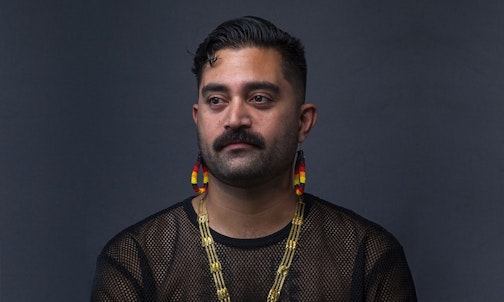‘o oganu‘u tupu: sovereign territories
Dr Léuli Eshrāghi
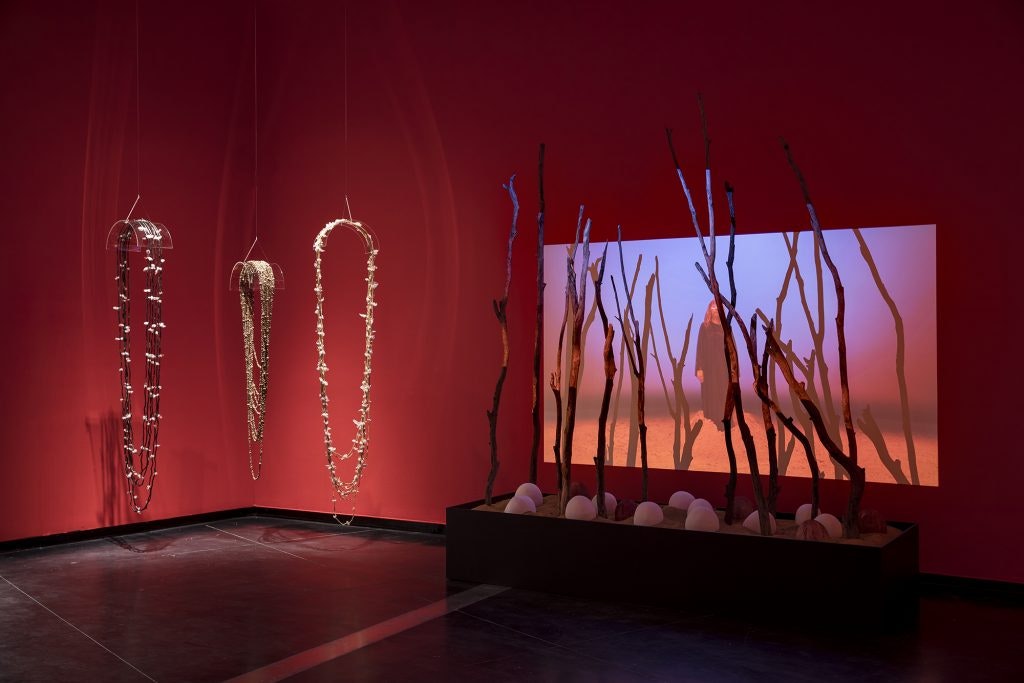
Maree Clarke, 'Born of the Land', 2014; Australian Centre for Contemporary Art, Sovereignty, 2016, photo: Andrew Curtis, courtesy the artist.
I offer fa‘amalama, votives of gratitude, a practice of illumination of knowledge through veneration of gods, ancestors, elders, lands and waters, to the Kulin Nation on whose unceded territory I live and work as an uninvited guest. I belong to the Sā Seumanutafa clan of the Sāmoan archipelago and other ancestries too. The following are some thoughts on the recent Australian Centre for Contemporary Art (ACCA) exhibition, Sovereignty, guest curated by Paola Balla (Wemba Wemba and Gunditjmara Nations) with ACCA’s Artistic Director, Max Delany, in Narrm Melbourne.
Sovereignty hopefully marks a departure from the Eurocentric programming and staffing of the previous thirteen years of ACCA’s existence under former Artistic Director, Juliana Engberg, who neglected and excluded contemporary Aboriginal arts practice in Australia. The fact remains that during Engberg’s tenure from 2003-2016, only six local and global Indigenous artists were part of group exhibitions. Six! Two Aboriginal artists in this time! Two! ACCA’s shift in increasing representation in its exhibition programming begins with its 2016 curatorial undertaking Painting. More Painting. Astoundingly, the last time a major group exhibition at ACCA centred on First Nations art practice in Australia (not including a few touring exhibitions) was Blakness: Blak City Culture! (1994), guest curated by Hetti Perkins with Clare Williamson. That is more than two decades between that show and Sovereignty.
Before I knew that Sovereignty was being developed for a scheduled December 2016 opening, I had often considered writing a speculative fiction review of the kind of solo exhibitions by First Nations women and non-binary artists, curated by Aboriginal women and non-binary curators, that ACCA and other institutions could strive to present. This was even before I began to engage professionally with Indigenous artistic and curatorial practices, both individual and collective, based in Aotearoa/New Zealand, Turtle Island/North America and Hawai’i. The incredible depth and breadth of work being produced and presented in these contexts belies the lack of engagement from Australian art institutions and art schools as much, one can only conclude, as that of their audiences and students.
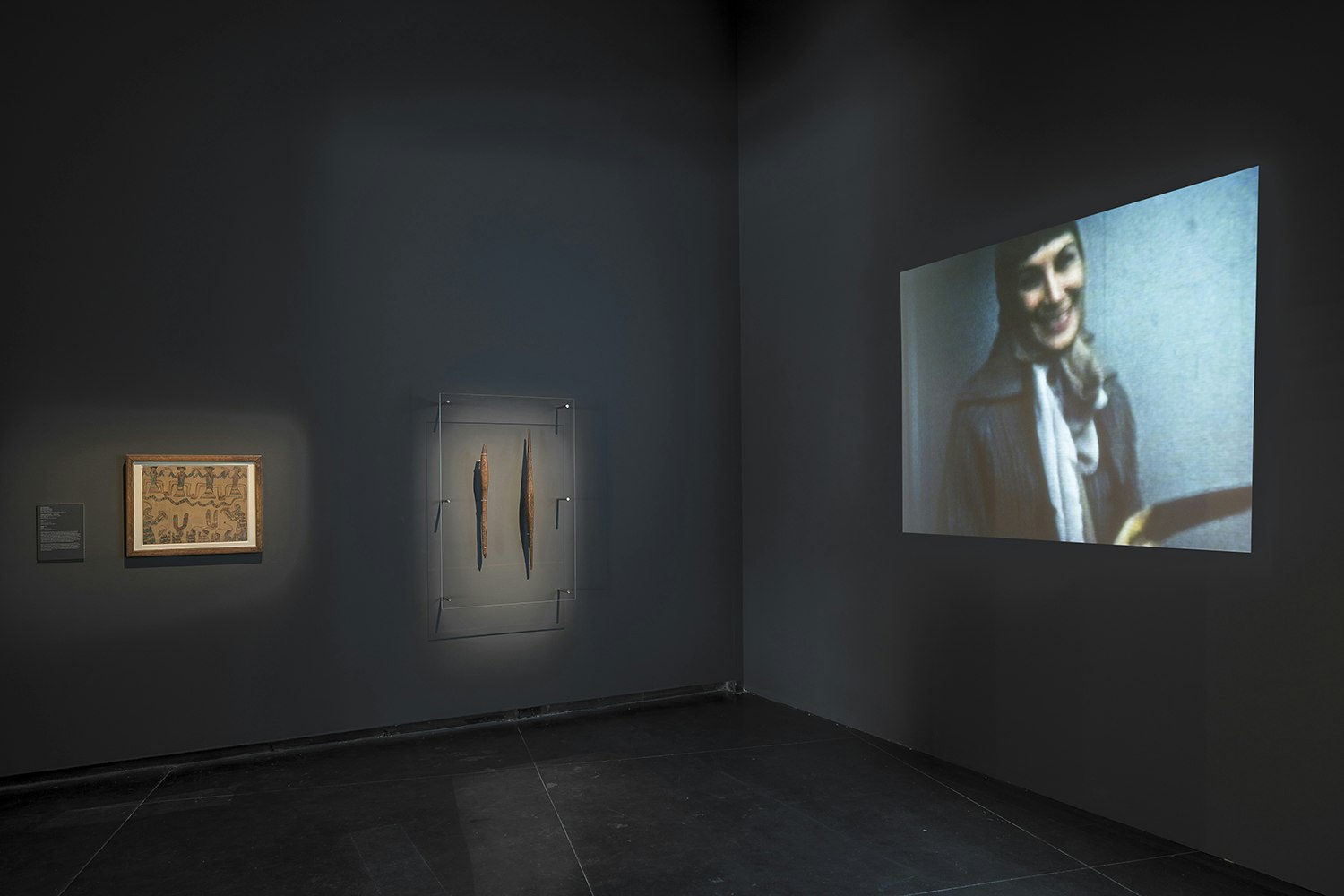
Sovereignty (installation view), Australian Centre for Contemporary Art, Melbourne (2016-17); photo: Andrew Curtis.
A number of positive reviews have already been written about Sovereignty (1). Key to understanding and engaging with this exhibition is a humble engagement with Indigenous knowledges, art and ceremonial practices, and living sovereign First Nations peoples and territories. We are at a crossroads in the journey of settler colonial states, institutions and communities beginning relationships with sovereign First Nations across the lands and waters called Australia. Tokenised representation in all manner of art schools, panels, exhibitions and public programming of local and global Indigenous peoples is normalised. It is nowhere near ideal. The cultural capital gained by settler curators working with, or enabling a guest curated project such as the two at ACCA I mentioned, undo the work of commissioning this kind of exhibition and public programming.
It seems we’ll forever be asking when critical mass—two or more First Nations staff in positions of authority and agency, depending on organisations’ size—will be reached in settler colonial institutions. As Yorta Yorta Nation curator Kimberley Moulton deftly discusses in her Sovereignty catalogue essay, ‘Should we be aiming for a non-colonial or anti-colonial space instead of trying to deconstruct the current imposing hold?’ (2) Moulton describes the continuing colonial constructs within which sovereign Indigenous artists, curators and writers resist and exist: Eurocentric art histories, art spaces, and art attitudes towards Indigenous peoples, territories, knowledges and rights.
The colossal emotional labour and curatorial magic that Paola Balla has brought to this project is without pair. Not only does Sovereignty mark the beginning of restoring Indigenous voice and agency in ‘public’ institutions (I said begin! There is so much to be done), the exhibition features carefully realised spaces for matriarchy, land and community rights and responsibilities, and agency specific to the First Peoples of southeastern Australia. Balla bears witness to contemporary cultural and political life: ‘The sovereignty of Indigenous peoples is being asserted in a cultural revolution of Indigenous activism, action and voice. (…) These actions can be considered expressions of sovereignty itself.’ (3) I particularly wish to pay homage to the stunning paintings by Aunty Marlene Gibson, cloaks by Aunty Glenda Nicholls, fish traps by Bronwyn Razem, pouches, crosses, pouches and cloaks by Vicki Couzens, and sculptural necklaces by Maree Clarke, amongst many other important, timeless works.
It is unfair to judge this exhibition and its diverse public programming in relation to the relative invisibility of First Nations and international Indigenous presence at ACCA and other similar art galleries, museums and schools in Australia. And yet, this could be the real time of change when at least two exhibitions (including solos) began to take place in the mainstream art institutions that to now continue to reflect and serve the European diaspora almost exclusively. This could be the time when directors, curators, public programmers, board members and audiences become more reflective of Indigenous peoples. This could be the time when local and global Indigenous curators, directors and public programmers curate exhibitions of their choice, having full agency over budgets and content.
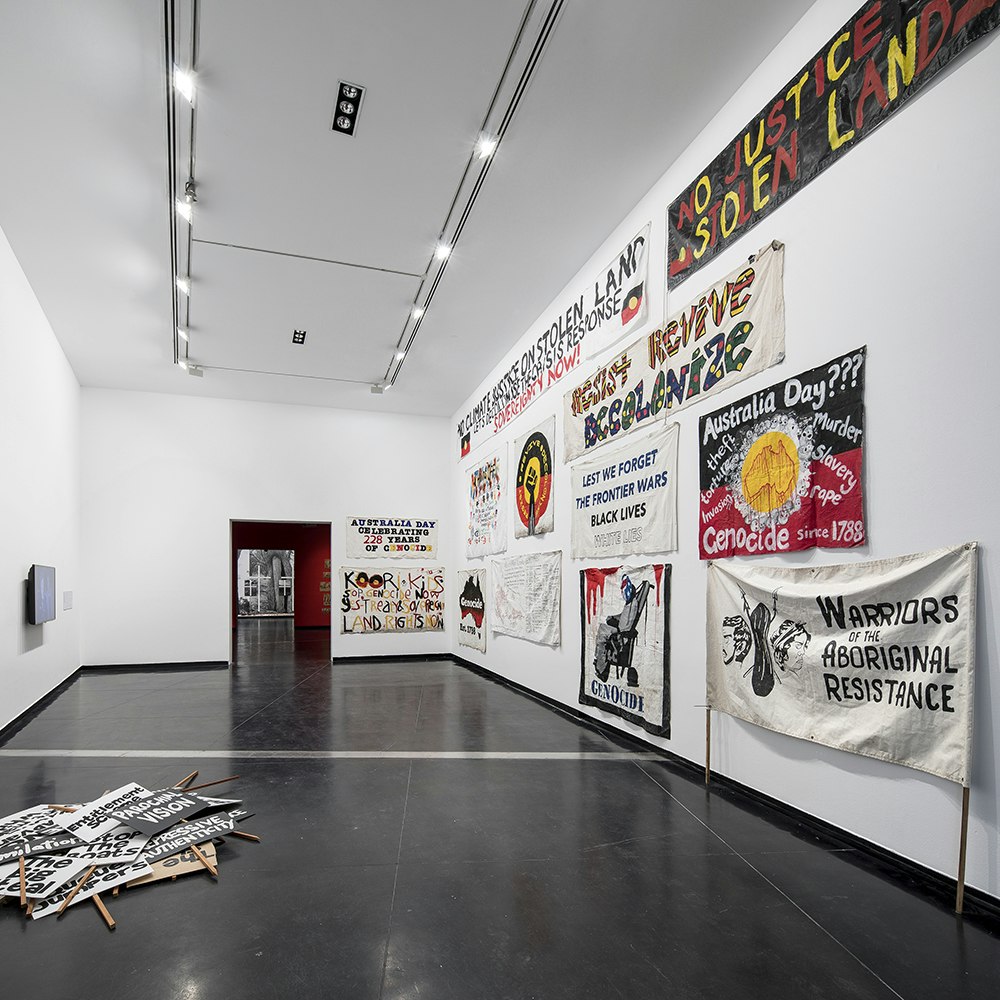
Sovereignty (installation view), Australian Centre for Contemporary Art, Melbourne (2016-17); photo: Andrew Curtis.
Inside institutional whiteness specific works challenge the flow of cultural capital to ‘woke’ settlers. I am thinking of the informative protest banners collected by the Warriors of the Aboriginal Resistance (WAR) that were used during Sovereignty’s duration. WAR is ‘a collective of young Aboriginal people committed to the cause of decolonisation and the philosophy of Aboriginal nationalism—resistance and revival. WAR has organised the largest and most poignant protests of my life: 50,000 people gathered in the Swanston and Flinders Streets intersection to counter the celebration of genocide and frontier wars on Invasion Day/Australia Day 2017.
Last July, WAR members chained themselves to a barred square for over 14 hours following a march from Parliament House to the same intersection, following the harrowing revelations on a ABC exposé of systemic abuse and torture of young Aboriginal children and teenagers, including Dylan Voller, at Don Dale Detention Centre near Garrmalang Darwin. The 4,000 protesters championed his plight, #shutdownDonDale and #handsoffAboriginalkids cried into the night. These contemporary activations of political, performance art serve First Nations sovereignties, bodies, communities and territories, not some abstract notion. In a settler colonial context where lands have not been returned to Aboriginal communities, protests reclaim territories, at least for a few hours, in ways that invigorate community spirit and practice.
Traumas of times passed are also resurfacing, particularly the British nuclear tests at Maralinga and Montebello in the 1950s, paralleled by American nuclear tests at Bikini, Enewetok and Kwajalein atolls in northern Oceania, and followed by French nuclear tests at Moruroa and Fangataufa atolls in southern Oceania. Yhonnie Scarce (Kokatha and Nukunu Nations) presents Strontium 90 (2016), chilling glass spheres on hospital cribs standing in for all the human and other lives lost in the nuclear tests on her ancestral territory, including families uncontacted by settlers. Her work shapes memory in ‘precarious, fragile forms which poetically record historical events both autobiographical and familial, ensuring that her family are never forgotten or lost within the labyrinthine administration of the colonial archive.’ (4) Having just visited the Honolulu Biennial in Hawai‘i where many artists addressed similar corporeal and ecological traumas due to nuclear colonisation, the toll on bodies, lands and spirits cannot be made visible enough, or sadly, undone.
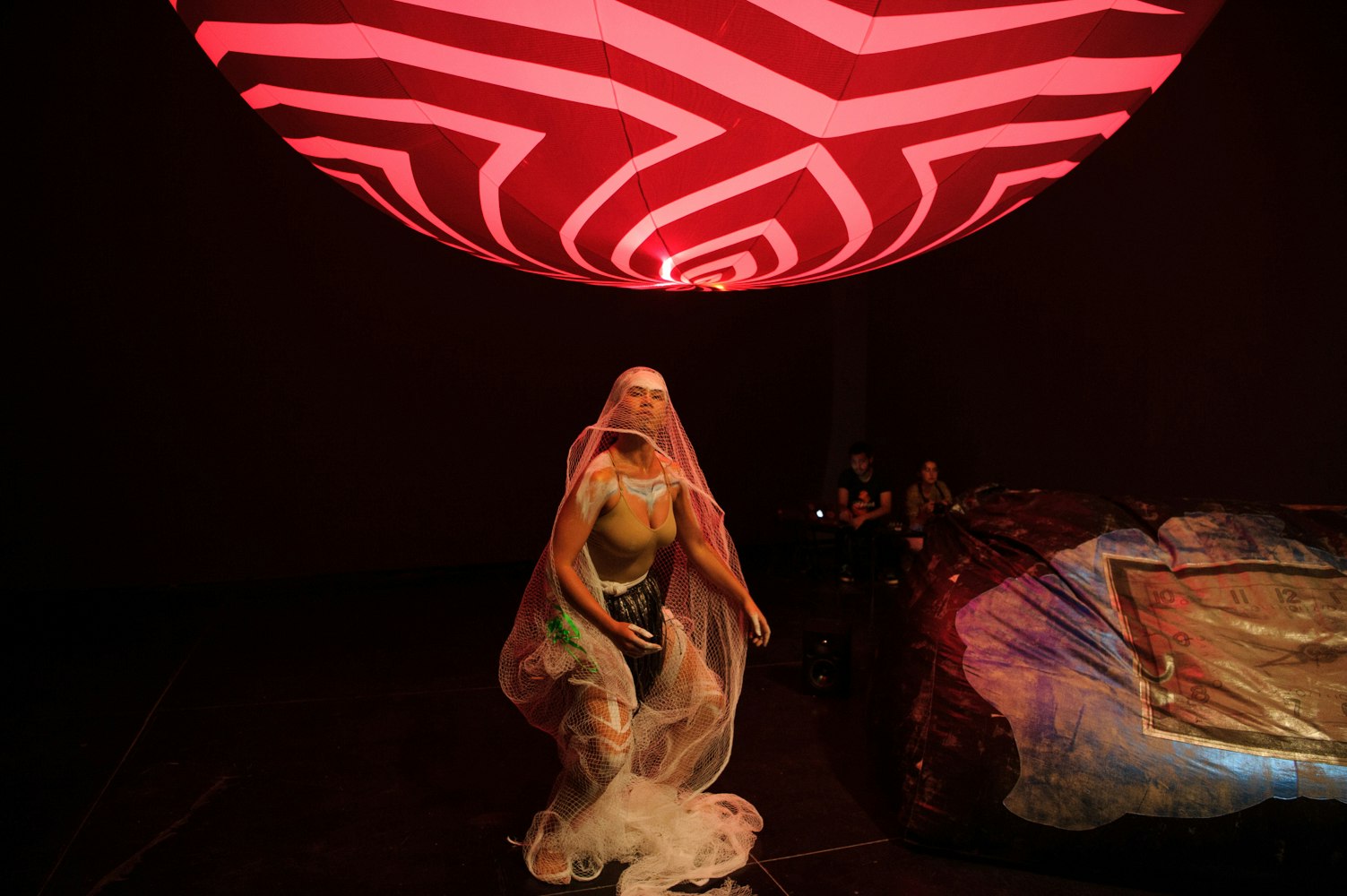
Amrita Hepi performing in Lukautim Solwara (Look out for the ocean), presented by Next Wave for Asia TOPA 2017 at the Australian Centre for Contemporary Art (showing installation by Brook Andrew in Sovereignty), 17 February 2017. Image courtesy Next Wave and Asia TOPA; photo: Sarah Walker.
At the culmination of the Lukautim Solwara (Look out for the ocean) (5) artists’ residency of which I was part, a one-night only performance at ACCA that was part of the inaugural Asia TOPA (Asia Pacific Triennial of Performing Arts) festival program supported by Next Wave and Arts Centre Melbourne. All eight of us in the project activated the space on our terms, for our own purposes. Rather than a performance for an anonymous public, the activations we offered were for each other, for the mana and agency of the ancestral belongings and newer works in the exhibition, and to honour the ancestors, lands and waters conjured within each exhibited work. Together we spanned many Indigenous territories and ceremonial knowledges, led by Rosanna Raymond (Sāmoan) with Reina Sutton (Tikopian, Malaitan), Jaimie Waititi (Te Whānau-ā-Apanui), Amrita Hepi (Ngāpuhi and Bundjalung), Thomas ES Kelly (Bundjalung, Wiradjuri and Tannese), Nicole Monks (Yamatji Wajarri), Steven Rhall (Taungwurrung) and myself. vaimea (waters of life/waters of fucking) made offerings to the gods, opened and scraped coconuts for more than an hour, discovering mouldy coconuts from rising sea levels, pre-packaged coconut water from tropical plantations far away, and a way to be barely clothed and dignified—clothed in ceremony and culture as we all came to see our work. My first live performance work still keeps me company and I look forward to bringing vaimea back for more activations here and abroad.
It was also an absolute honour to be a speaker in the Culture First symposium on Indigenous curatorial practices as part of Sovereignty’s public programming, with Paola Balla, Kimberley Moulton and Hannah Donnelly (Wiradjuri Nation). Knowing each other well, we were able to offer generous, incisive thoughts on Indigenous modes of organising and presenting cultural practices. We also hosted a yarning circle and professional development session for local and global Indigenous artists, curators and writers, called For Us By Us, which has continued to be an important space for sharing and growing professionally and culturally, well after the exhibition closed at ACCA. These spaces of relationships outside of a non-Indigenous gaze serve our collective futures and presents, enabling us to imagine possibilities.
Many of us would like to see commitments to non-tokenised and regular Indigenous art exhibitions, staff, boards and audiences. Significantly, I wish to see settler colonial institutions engage with First Nations governments, artists, curators, writers, languages, knowledges and territories from positions of humility and learning. I wish to see exhibitions and events curated by Indigenous curators and directors from across these lands and waters, and from other territories overseas, particularly Turtle Island/North America, Hawai‘i, Aotearoa/New Zealand, Kanaky/New Caledonia and Taiwan. This is to redress histories of exclusion that continue to now, so we may all become possible together, distinct and hopeful.
I offer my installation work, Absences (2016), in text form below as a respectful honouring of the cultural and political revival of the Wurundjeri people of the wider Kulin Nation. Ia manuia le tou soifua, I wish you all wellbeing.
(i) Here
in Occupied
Unceded
Wurundjeri
Biik
Country
A European diaspora
holds fast its grip
Presenting Storing
Preserving Knowledges
Bodies Economies
Ecologies
Gleaned, from homelands over seas
(ii) Here
First Nations peoples across worlds and relations
thrive and endure
incessant recordings of
Ceremonies
Massacres
Villages
In European trends
and tongues
In master planned colonies
Arrogantly arriving
In territories
With senses shut
To finely cared for
Moieties
Forests
Rivers
(iii) Here
My brown body From the moana ocean
Born of fanua country
Stands
Here
My brown body Not an erotic/exotic other
To consume
Humbled by Kulin peoples
Biik country
Mana presence
Grow my hair
loa long loa long loa long
loa long
Tā moments passing
Keep vā, with
Tupuga ancestors mount Vaea
healing waters Loimata o Apaula
From before
Our forced inclusion
In German/New Zealand/American
Empires of
Mark
Pound
Dollar
Permitted worship
… After their late capitalist ending
Who should die? Whose fair country?
When?
From continuing
dark times
To tread
lightly
(iv) Here
Imagine manna forests laughing children
Toorook wetlands singing communities
Murnong gardens dancing welcomes
Wilam households flying healthy birds
I see possum skin cloaks
mapping kin and country
I see rivers, forests, villages
drawings, fires, dances, songs
And Wurundjeri culture cherished
sited // cited
centre // place
Know this restoration
In Bunjil and Waa’s embrace
Here
Near the Wurundjeri Land Council
On the bends of
Merri yaluk
and
Birrarung yaluk
Nourishing Kulin
Since forever
Since Gregorian 1840
Notes
(1) For example, Hannah Donnelly, ‘Field of view Sovereignty: a future tense interview with VR (Virtual REality) curators based on yarns with Paola Balla and Max Delany’, Broadsheet Journal 46:1 (2017) 20-24; and Eugenia Flynn, ‘Review: Sovereignty’, Art + Australia (2017).
(2) Kimberley Moulton, ‘Sovereign art and the colonial canon: are we lost until we are found?’, in Sovereignty, curators Paola Balla and Max Delany (ex. cat. Melbourne: Australian Centre for Contemporary Art, 2016), 29.
(3) Paola Balla, ‘Sovereignty: inalienable and intimate’, in Sovereignty, curators Paola Balla and Max Delany (ex. cat. Melbourne: Australian Centre for Contemporary Art, 2016), 13.
(4) Paola Balla, 2016, ibid.,14.
(5) See this Nithya Iyer, ‘Review: Lukautim solwara (Look out for the ocean)’ Peril, 27 February 2017.
About the contributor
Dr Léuli Eshrāghi, Sāmoan artist, curator and researcher, intervenes in display territories to centre Indigenous presence and power, sensual and spoken languages, and ceremonial–political practices.
